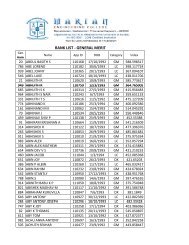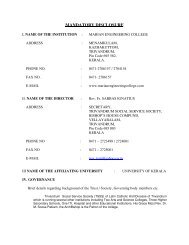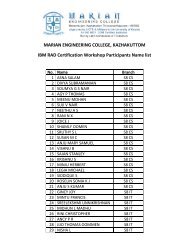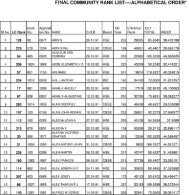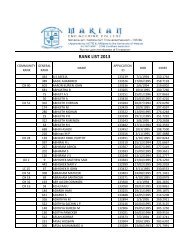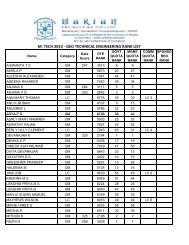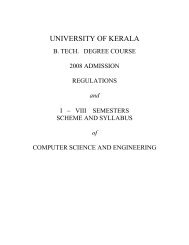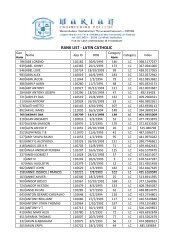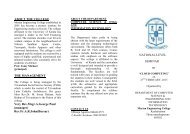UNIVERSITY OF KERALA - College of Engineering, Trivandrum
UNIVERSITY OF KERALA - College of Engineering, Trivandrum
UNIVERSITY OF KERALA - College of Engineering, Trivandrum
Create successful ePaper yourself
Turn your PDF publications into a flip-book with our unique Google optimized e-Paper software.
08. 304 CONCRETE TECHNOLOGY L T P/D Cr<br />
Module I<br />
2 1 0 3<br />
Materials:-Cement – Ingredients, Chemical composition, basic properties <strong>of</strong> cement compounds,<br />
Hydration <strong>of</strong> cement- heat <strong>of</strong> hydration, physical properties <strong>of</strong> Portland cements, Indian standard tests and<br />
specification, various types and grades <strong>of</strong> cement, storage <strong>of</strong> cement<br />
Aggregates:- Classification <strong>of</strong> aggregates based on size, shape, unit weight and its geological origin.<br />
Characteristics <strong>of</strong> aggregates – Strength <strong>of</strong> aggregate, particle shape and texture, specific gravity, bulk density,<br />
porosity, moisture content <strong>of</strong> aggregate, bulking <strong>of</strong> fine aggregate, deleterious substance in aggregate,<br />
soundness <strong>of</strong> aggregate , alkali- aggregate reaction , sieve analysis:- grading curves, fineness modulus, grading<br />
requirements, grading <strong>of</strong> fine and coarse aggregates, zoning, IS tests and specification for aggregates for<br />
concrete.<br />
Water: - Quality <strong>of</strong> mixing water, effect <strong>of</strong> impurities in water on properties <strong>of</strong> concrete.<br />
Admixtures:- Functions and classification <strong>of</strong> admixtures, factors influencing the dosage <strong>of</strong> different<br />
admixtures- IS specification for admixtures for concrete.<br />
Module II<br />
Properties <strong>of</strong> fresh concrete:- Water/ Cement ratio and its significance in fresh concrete- workability- different<br />
methods for assessing workability according to IS Specification, factors affecting workability, requirements <strong>of</strong><br />
workability for various work, segregation, bleeding, setting, hardening, strength development.<br />
Process <strong>of</strong> manufacture <strong>of</strong> Concrete:- Mix proportion and grade <strong>of</strong> concrete, Various types <strong>of</strong> batching,<br />
mixing, transporting, placing, compacting, curing and finishing <strong>of</strong> concrete. Joints in concreting – construction<br />
and expansion.<br />
Special concrete (Brief discussion only): Lightweight concrete, High strength concrete, Polymer concrete,<br />
fiber reinforced concrete, Fero-cement, Ready mixed concrete.<br />
Formwork for concrete:- Materials used for formwork- formwork for beams, columns, slabs.<br />
Module III<br />
Properties <strong>of</strong> Hardened concrete:- Strength <strong>of</strong> concrete- factors influencing the strength <strong>of</strong> concrete, Stress<br />
and strain characteristics <strong>of</strong> concrete, I S tests for assessing the performance <strong>of</strong> hardened concrete, Effect <strong>of</strong><br />
creep, shrinkage and temperature. Durability <strong>of</strong> concrete, factors affecting durability - permeability, chemical<br />
attack, sea water attack and air entrainment<br />
Non-destructive testing <strong>of</strong> concrete:-Rebound hammer and ultrasonic pulse velocity testing<br />
Mix Design:- Quality Control - Factors causing variations in the quality <strong>of</strong> concrete -statistical quality control,<br />
quality management in concrete construction, Proportioning <strong>of</strong> concrete mixes- factors influencing the choice <strong>of</strong><br />
mix proportions, General principles <strong>of</strong> concrete mix deign by IS Method, Importance <strong>of</strong> trial mixes and<br />
adjustment <strong>of</strong> ingredients <strong>of</strong> concrete.<br />
References:<br />
1 A.M.Neville, Concrete Technology- Pearson Education<br />
2 A.M.Neville, Properties <strong>of</strong> Concrete 4/e, Pearson Education<br />
3 Peurifoy R.l & Ledbetter W.B, Construction planning & Methods, MGH Publishers.<br />
4 M.S.Shetty, Concrete Technology , S I Chand & Company.<br />
5.Gambhin M.L., Concrete Technology, Tata McGraw Hill<br />
6.Krishna Raju N., Design <strong>of</strong> Concrete Mixes, CBS publishers<br />
7 A. R. Santhakumar, Concrete Technology , Oxford University Press,India(2006)<br />
Question Paper: Duration: 3 hours<br />
The question paper consists <strong>of</strong> Part A and Part B.<br />
Part A is for 40 marks. There will be 8 compulsory short answer questions <strong>of</strong> 5 marks each covering entire<br />
syllabus<br />
.Part B is for 60 marks. There will be two questions from each module. The candidate has to answer one<br />
question <strong>of</strong> 20 marks from each module.<br />
Note: No charts, tables, codes are permitted in the Examination hall .If necessary relevant data shall be given<br />
along with the question paper by the question paper setter.<br />
31



